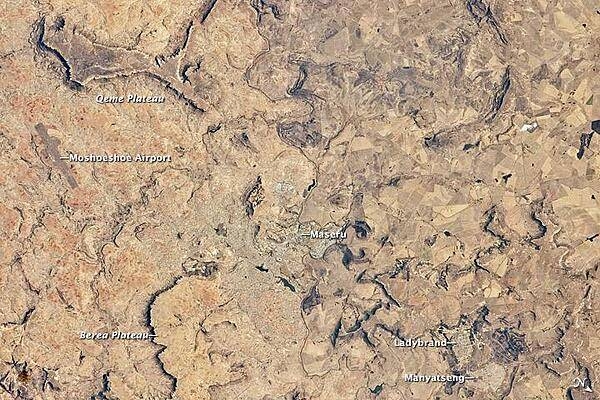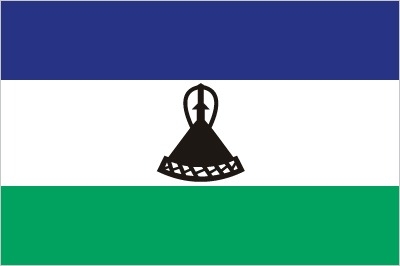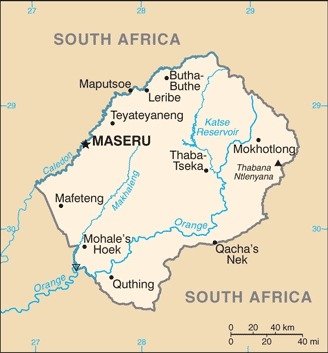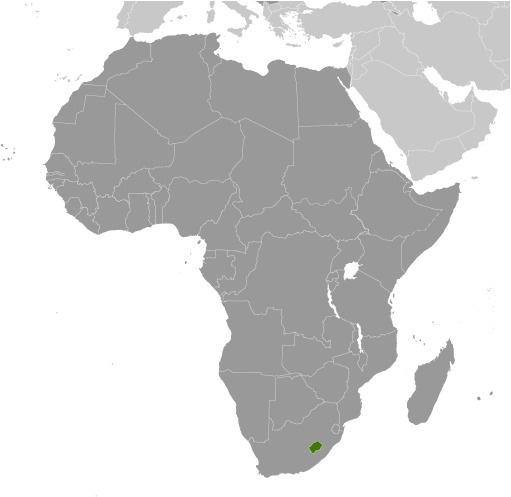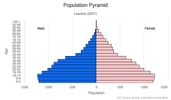Lesotho
Introduction
Background
Paramount chief MOSHOESHOE I consolidated what would become Basutoland in the early 19th century and made himself king in 1822. Continuing encroachments by Dutch settlers from the neighboring Orange Free State caused the king to enter into an 1868 agreement with the UK by which Basutoland became a British protectorate, and after 1884, a crown colony. Upon independence in 1966, the country was renamed the Kingdom of Lesotho. The Basotho National Party ruled the country during its first two decades. King MOSHOESHOE II was exiled in 1990, but returned to Lesotho in 1992 and was reinstated in 1995 and subsequently succeeded by his son, King LETSIE III, in 1996. Constitutional government was restored in 1993 after seven years of military rule. In 1998, violent protests and a military mutiny following a contentious election prompted a brief but bloody intervention by South African and Botswana military forces under the aegis of the Southern African Development Community. Subsequent constitutional reforms restored relative political stability. Peaceful parliamentary elections were held in 2002, but the National Assembly elections in 2007 were hotly contested and aggrieved parties disputed how the electoral law was applied to award proportional seats in the Assembly. In 2012, competitive elections involving 18 parties saw Prime Minister Motsoahae Thomas THABANE form a coalition government - the first in the country's history - that ousted the 14-year incumbent, Pakalitha MOSISILI, who peacefully transferred power the following month. MOSISILI returned to power in snap elections in February 2015 after the collapse of THABANE’s coalition government and an alleged attempted military coup. In June 2017, THABANE returned to become prime minister.
Visit the Definitions and Notes page to view a description of each topic.
Geography
Location
Southern Africa, an enclave of South Africa
Geographic coordinates
29 30 S, 28 30 E
Map references
Africa
Land boundaries
total: 1,106 km
border countries (1): South Africa 1106 km
Coastline
0 km (landlocked)
Maritime claims
none (landlocked)
Climate
temperate; cool to cold, dry winters; hot, wet summers
Terrain
mostly highland with plateaus, hills, and mountains
Elevation
highest point: Thabana Ntlenyana 3,482 m
lowest point: junction of the Orange and Makhaleng Rivers 1,400 m
mean elevation: 2,161 m
Natural resources
water, agricultural and grazing land, diamonds, sand, clay, building stone
Land use
agricultural land: 76.1% (2018 est.)
arable land: 10.1% (2018 est.)
permanent crops: 0.1% (2018 est.)
permanent pasture: 65.9% (2018 est.)
forest: 1.5% (2018 est.)
other: 22.4% (2018 est.)
Irrigated land
30 sq km (2012)
Major watersheds (area sq km)
Atlantic Ocean drainage: Orange (941,351 sq km)
Major rivers (by length in km)
Orange river source (shared with South Africa and Namibia [m]) - 2,092 km
note – [s] after country name indicates river source; [m] after country name indicates river mouth
Population distribution
relatively higher population density in the western half of the nation, with the capital of Maseru, and the smaller cities of Mafeteng, Teyateyaneng, and Leribe attracting the most people as shown in this population distribution map
Natural hazards
periodic droughts
Geography - note
landlocked, an enclave of (completely surrounded by) South Africa; mountainous, more than 80% of the country is 1,800 m above sea level
People and Society
Population
2,177,740 (July 2021 est.)
note: estimates for this country explicitly take into account the effects of excess mortality due to AIDS; this can result in lower life expectancy, higher infant mortality, higher death rates, lower population growth rates, and changes in the distribution of population by age and sex than would otherwise be expected
Nationality
noun: Mosotho (singular), Basotho (plural)
adjective: Basotho
Ethnic groups
Sotho 99.7%, Europeans, Asians, and other 0.3%
Languages
Sesotho (official) (southern Sotho), English (official), Zulu, Xhosa
Religions
Protestant 47.8% (Pentecostal 23.1%, Lesotho Evangelical 17.3%, Anglican 7.4%), Roman Catholic 39.3%, other Christian 9.1%, non-Christian 1.4%, none 2.3% (2014 est.)
Demographic profile
Lesotho faces great socioeconomic challenges. More than half of its population lives below the property line, and the country’s HIV/AIDS prevalence rate is the second highest in the world. In addition, Lesotho is a small, mountainous, landlocked country with little arable land, leaving its population vulnerable to food shortages and reliant on remittances. Lesotho’s persistently high infant, child, and maternal mortality rates have been increasing during the last decade, according to the last two Demographic and Health Surveys. Despite these significant shortcomings, Lesotho has made good progress in education; it is on-track to achieve universal primary education and has one of the highest adult literacy rates in Africa.
Lesotho’s migration history is linked to its unique geography; it is surrounded by South Africa with which it shares linguistic and cultural traits. Lesotho at one time had more of its workforce employed outside its borders than any other country. Today remittances equal about 17% of its GDP. With few job options at home, a high rate of poverty, and higher wages available across the border, labor migration to South Africa replaced agriculture as the prevailing Basotho source of income decades ago. The majority of Basotho migrants were single men contracted to work as gold miners in South Africa. However, migration trends changed in the 1990s, and fewer men found mining jobs in South Africa because of declining gold prices, stricter immigration policies, and a preference for South African workers.
Although men still dominate cross-border labor migration, more women are working in South Africa, mostly as domestics, because they are widows or their husbands are unemployed. Internal rural-urban flows have also become more frequent, with more women migrating within the country to take up jobs in the garment industry or moving to care for loved ones with HIV/AIDS. Lesotho’s small population of immigrants is increasingly composed of Taiwanese and Chinese migrants who are involved in the textile industry and small retail businesses.
Age structure
0-14 years: 31.3% (male 309,991/female 306,321)
15-24 years: 19.26% (male 181,874/female 197,452)
25-54 years: 38.86% (male 373,323/female 391,901)
55-64 years: 4.98% (male 52,441/female 45,726)
65 years and over: 5.6% (male 57,030/female 53,275) (2020 est.)
Dependency ratios
total dependency ratio: 59.2
youth dependency ratio: 51.3
elderly dependency ratio: 7.9
potential support ratio: 12.7 (2020 est.)
Median age
total: 24.7 years
male: 24.7 years
female: 24.7 years (2020 est.)
Population distribution
relatively higher population density in the western half of the nation, with the capital of Maseru, and the smaller cities of Mafeteng, Teyateyaneng, and Leribe attracting the most people as shown in this population distribution map
Urbanization
urban population: 29.5% of total population (2021)
rate of urbanization: 2.77% annual rate of change (2020-25 est.)
Major urban areas - population
202,000 MASERU (capital) (2018)
Sex ratio
at birth: 1.03 male(s)/female
0-14 years: 1.01 male(s)/female
15-24 years: 0.92 male(s)/female
25-54 years: 0.95 male(s)/female
55-64 years: 1.15 male(s)/female
65 years and over: 1.07 male(s)/female
total population: 0.98 male(s)/female (2020 est.)
Mother's mean age at first birth
20.9 years (2014 est.)
note: median age at first birth among women 25-49
Maternal mortality ratio
544 deaths/100,000 live births (2017 est.)
country comparison to the world: 17Infant mortality rate
total: 50.23 deaths/1,000 live births
male: 55.92 deaths/1,000 live births
female: 44.37 deaths/1,000 live births (2021 est.)
Life expectancy at birth
total population: 58.9 years
male: 56.82 years
female: 61.04 years (2021 est.)
Contraceptive prevalence rate
64.9% (2018)
Drinking water source
improved: urban: 93% of population
rural: 72.4% of population
total: 78.2% of population
unimproved: urban: 7% of population
rural: 27.6% of population
total: 21.8% of population (2017 est.)
Current Health Expenditure
9.3% (2018)
Physicians density
0.07 physicians/1,000 population
Sanitation facility access
improved: urban: 88.6% of population
rural: 52.3% of population
total: 62.4% of population
unimproved: urban: 11.4% of population
rural: 47.7% of population
total: 37.6% of population (2017 est.)
Major infectious diseases
degree of risk: intermediate (2020)
food or waterborne diseases: bacterial diarrhea, hepatitis A, and typhoid fever
Literacy
definition: age 15 and over can read and write
total population: 79.4%
male: 70.1%
female: 88.3% (2015)
School life expectancy (primary to tertiary education)
total: 12 years
male: 12 years
female: 13 years (2017)
Unemployment, youth ages 15-24
total: 35.5%
male: 31.2% NA
female: 41.5% NA (2019 est.)
Environment
Environment - current issues
population pressure forcing settlement in marginal areas results in overgrazing, severe soil erosion, and soil exhaustion; desertification; Highlands Water Project controls, stores, and redirects water to South Africa
Environment - international agreements
party to: Biodiversity, Climate Change, Climate Change-Kyoto Protocol, Climate Change-Paris Agreement, Comprehensive Nuclear Test Ban, Desertification, Endangered Species, Hazardous Wastes, Law of the Sea, Marine Life Conservation, Ozone Layer Protection, Wetlands
signed, but not ratified: none of the selected agreements
Air pollutants
particulate matter emissions: 27.78 micrograms per cubic meter (2016 est.)
carbon dioxide emissions: 2.51 megatons (2016 est.)
methane emissions: 2.56 megatons (2020 est.)
Climate
temperate; cool to cold, dry winters; hot, wet summers
Land use
agricultural land: 76.1% (2018 est.)
arable land: 10.1% (2018 est.)
permanent crops: 0.1% (2018 est.)
permanent pasture: 65.9% (2018 est.)
forest: 1.5% (2018 est.)
other: 22.4% (2018 est.)
Urbanization
urban population: 29.5% of total population (2021)
rate of urbanization: 2.77% annual rate of change (2020-25 est.)
Revenue from forest resources
forest revenues: 3.34% of GDP (2018 est.)
country comparison to the world: 22Major infectious diseases
degree of risk: intermediate (2020)
food or waterborne diseases: bacterial diarrhea, hepatitis A, and typhoid fever
Food insecurity
severe localized food insecurity:
due to localized shortfalls in production and loss of income-generating activities - a slow economic recovery in 2021 will continue to impose constraints on households’ incomes, impinging on their economic capacity to access food; overall, the number of food insecure people is expected to decline from the estimated 582,000 that faced acute food insecurity in the October 2020−March 2021 period; the possibility of a third wave of COVID‑19 cases in the country and neighboring South Africa, increases the risk for the enforcement of new containment measures, which could prolong the high levels of unemployment and cause further income losses among the most vulnerable households
(2021)Waste and recycling
municipal solid waste generated annually: 73,457 tons (2006 est.)
Major rivers (by length in km)
Orange river source (shared with South Africa and Namibia [m]) - 2,092 km
note – [s] after country name indicates river source; [m] after country name indicates river mouth
Major watersheds (area sq km)
Atlantic Ocean drainage: Orange (941,351 sq km)
Total water withdrawal
municipal: 20 million cubic meters (2017 est.)
industrial: 20 million cubic meters (2017 est.)
agricultural: 3.8 million cubic meters (2017 est.)
Total renewable water resources
3.022 billion cubic meters (2017 est.)
Government
Country name
conventional long form: Kingdom of Lesotho
conventional short form: Lesotho
local long form: Kingdom of Lesotho
local short form: Lesotho
former: Basutoland
etymology: the name translates as "Land of the Sesotho Speakers"
Government type
parliamentary constitutional monarchy
Capital
name: Maseru
geographic coordinates: 29 19 S, 27 29 E
time difference: UTC+2 (7 hours ahead of Washington, DC, during Standard Time)
etymology: in the Sesotho language the name means "[place of] red sandstones"
Administrative divisions
10 districts; Berea, Butha-Buthe, Leribe, Mafeteng, Maseru, Mohale's Hoek, Mokhotlong, Qacha's Nek, Quthing, Thaba-Tseka
Independence
4 October 1966 (from the UK)
National holiday
Independence Day, 4 October (1966)
Constitution
history: previous 1959, 1967; latest adopted 2 April 1993 (effectively restoring the 1967 version)
amendments: proposed by Parliament; passage of amendments affecting constitutional provisions, including fundamental rights and freedoms, sovereignty of the kingdom, the office of the king, and powers of Parliament, requires a majority vote by the National Assembly, approval by the Senate, approval in a referendum by a majority of qualified voters, and assent of the king; passage of amendments other than those specified provisions requires at least a two-thirds majority vote in both houses of Parliament; amended several times, last in 2011
Legal system
mixed legal system of English common law and Roman-Dutch law; judicial review of legislative acts in High Court and Court of Appeal
International law organization participation
accepts compulsory ICJ jurisdiction with reservations; accepts ICCt jurisdiction
Citizenship
citizenship by birth: yes
citizenship by descent only: yes
dual citizenship recognized: no
residency requirement for naturalization: 5 years
Suffrage
18 years of age; universal
Executive branch
chief of state: King LETSIE III (since 7 February 1996); note - King LETSIE III formerly occupied the throne from November 1990 to February 1995 while his father was in exile
head of government: Prime Minister Moeketsi MAJORO (since 20 May 2020); note - Prime Minister Thomas THABANE resigned on 19 May 2020
cabinet: consists of the prime minister, appointed by the King on the advice of the Council of State, the deputy prime minister, and 26 other ministers
elections/appointments: the monarchy is hereditary, but under the terms of the constitution that came into effect after the March 1993 election, the monarch is a "living symbol of national unity" with no executive or legislative powers; under traditional law, the college of chiefs has the power to depose the monarch, to determine next in line of succession, or to serve as regent in the event that a successor is not of mature age; following legislative elections, the leader of the majority party or majority coalition in the Assembly automatically becomes prime minister
Legislative branch
description: bicameral Parliament consists of:
Senate (33 seats; 22 principal chiefs and 11 other senators nominated by the king with the advice of the Council of State, a 13-member body of key government and non-government officials; members serve 5-year terms)
National Assembly (120 seats; 80 members directly elected in single-seat constituencies by simple majority vote and 40 elected through proportional representation; members serve 5-year terms)
elections: Senate - last nominated by the king 11 July 2017 (next NA)
National Assembly - last held on 3 June 2017 (next to be held in 2022)
election results: Senate - percent of votes by party - NA, seats by party - NA; composition - men 25, women 8, percent of women 24.2%
National Assembly - percent of votes by party - ABC 40.5%, DC 25.8%, LCD 9%, AD 7.3%, MEC 5.1%, BNP 4.1, PFD 2.3%, other 5.9%; seats by party - ABC 51, DC 30, LCD 11, AD 9, MEC 6, BNP 5, PFD 3, other 5; composition - men 95, women 27, percent of women 22.5%; note - total Parliament percent of women 22.9%
Judicial branch
highest courts: Court of Appeal (consists of the court president, such number of justices of appeal as set by Parliament, and the Chief Justice and the puisne judges of the High Court ex officio); High Court (consists of the chief justice and such number of puisne judges as set by Parliament); note - both the Court of Appeal and the High Court have jurisdiction in constitutional issues
judge selection and term of office: Court of Appeal president and High Court chief justice appointed by the monarch on the advice of the prime minister; puisne judges appointed by the monarch on advice of the Judicial Service Commission, an independent body of judicial officers and officials designated by the monarch; judges of both courts can serve until age 75
subordinate courts: Magistrate Courts; customary or traditional courts; military courts
Political parties and leaders
All Basotho Convention or ABC [Moeketsi MAJORO]
Alliance of Democrats or AD [Monyane MOLELEKI]
Basotho Action Party or BAP [Ngosa MAHAO]
Basotho National Party or BNP [Thesele MASERIBANE]
Democratic Congress or DC [Mathibeli MOKHOTHU]
Democratic Party of Lesotho or DPL [Limpho TAU]
Lesotho Congress for Democracy or LCD [Mothetjoa METSING]
Movement of Economic Change or MEC [Selibe MOCHOBOROANE]
National Independent Party or NIP [Kimetso MATHABA]
Popular Front for Democracy of PFD [Lekhetho RAKUOANE]
Reformed Congress of Lesotho or RCL [Keketso RANTSO]
International organization participation
ACP, AfDB, AU, C, CD, FAO, G-77, IAEA, IBRD, ICAO, ICCt, ICRM, IDA, IFAD, IFC, IFRCS, ILO, IMF, Interpol, IOC, IOM, IPU, ISO (correspondent), ITU, MIGA, NAM, OPCW, SACU, SADC, UN, UNAMID, UNCTAD, UNESCO, UNHCR, UNIDO, UNWTO, UPU, WCO, WFTU (NGOs), WHO, WIPO, WMO, WTO
Diplomatic representation in the US
chief of mission: Ambassador Sankatana Gabriel MAJA, Counselor (28 May 2021)
chancery: 2511 Massachusetts Avenue NW, Washington, DC 20008
telephone: [1] (202) 797-5533
FAX: [1] (202) 234-6815
email address and website:
lesothoembassy@verizon.net
https://www.gov.ls/
Diplomatic representation from the US
chief of mission: Ambassador Rebecca E. GONZALES (since 8 February 2018)
embassy: 254 Kingsway Avenue, Maseru
mailing address: 2340 Maseru Place, Washington DC 20521-2340
telephone: [266] 22312666
FAX: [266] 22310116
email address and website:
USConsularMaseru@state.gov
https://ls.usembassy.gov/
Flag description
three horizontal stripes of blue (top), white, and green in the proportions of 3:4:3; the colors represent rain, peace, and prosperity respectively; centered in the white stripe is a black Basotho hat representing the indigenous people; the flag was unfurled in October 2006 to celebrate 40 years of independence
National symbol(s)
mokorotio (Basotho hat); national colors: blue, white, green, black
National anthem
name: "Lesotho fatse la bo ntat'a rona" (Lesotho, Land of Our Fathers)
lyrics/music: Francois COILLARD/Ferdinand-Samuel LAUR
note: adopted 1967; music derives from an 1823 Swiss songbook
Economy
Economic overview
Small, mountainous, and completely landlocked by South Africa, Lesotho depends on a narrow economic base of textile manufacturing, agriculture, remittances, and regional customs revenue. About three-fourths of the people live in rural areas and engage in animal herding and subsistence agriculture, although Lesotho produces less than 20% of the nation's demand for food. Agriculture is vulnerable to weather and climate variability.
Lesotho relies on South Africa for much of its economic activity; Lesotho imports 85% of the goods it consumes from South Africa, including most agricultural inputs. Households depend heavily on remittances from family members working in South Africa in mines, on farms, and as domestic workers, though mining employment has declined substantially since the 1990s. Lesotho is a member of the Southern Africa Customs Union (SACU), and revenues from SACU accounted for roughly 26% of total GDP in 2016; however, SACU revenues are volatile and expected to decline over the next 5 years. Lesotho also gains royalties from the South African Government for water transferred to South Africa from a dam and reservoir system in Lesotho. However, the government continues to strengthen its tax system to reduce dependency on customs duties and other transfers.
The government maintains a large presence in the economy - government consumption accounted for about 26% of GDP in 2017. The government remains Lesotho's largest employer; in 2016, the government wage bill rose to 23% of GDP – the largest in Sub-Saharan Africa. Lesotho's largest private employer is the textile and garment industry - approximately 36,000 Basotho, mainly women, work in factories producing garments for export to South Africa and the US. Diamond mining in Lesotho has grown in recent years and accounted for nearly 35% of total exports in 2015. Lesotho managed steady GDP growth at an average of 4.5% from 2010 to 2014, dropping to about 2.5% in 2015-16, but poverty remains widespread around 57% of the total population.
Real GDP (purchasing power parity)
$4.88 billion note: data are in 2017 dollars (2020 est.)
$5.49 billion note: data are in 2017 dollars (2019 est.)
$5.51 billion note: data are in 2017 dollars (2018 est.)
note: data are in 2010 dollars
Real GDP growth rate
-1.6% (2017 est.)
3.1% (2016 est.)
2.5% (2015 est.)
Real GDP per capita
$2,300 note: data are in 2017 dollars (2020 est.)
$2,600 note: data are in 2017 dollars (2019 est.)
$2,600 note: data are in 2017 dollars (2018 est.)
note: data are in 2010 dollars
GDP (official exchange rate)
$2.462 billion (2019 est.)
Inflation rate (consumer prices)
5.3% (2019 est.)
3.8% (2018 est.)
5.1% (2017 est.)
Credit ratings
Fitch rating: B (2019)
GDP - composition, by sector of origin
agriculture: 5.8% (2016 est.)
industry: 39.2% (2016 est.)
services: 54.9% (2017 est.)
GDP - composition, by end use
household consumption: 69.2% (2017 est.)
government consumption: 26.4% (2017 est.)
investment in fixed capital: 31.4% (2017 est.)
investment in inventories: -13.4% (2017 est.)
exports of goods and services: 40.8% (2017 est.)
imports of goods and services: -54.4% (2017 est.)
Agricultural products
milk, potatoes, maize, vegetables, fruit, beef, game meat, mutton, beans, wool
Industries
food, beverages, textiles, apparel assembly, handicrafts, construction, tourism
Labor force - by occupation
agriculture: 86%
industry and services: 14% (2002 est.)
note: most of the resident population is engaged in subsistence agriculture; roughly 35% of the active male wage earners work in South Africa
Population below poverty line
49.7% (2017 est.)
Gini Index coefficient - distribution of family income
44.9 (2017 est.)
56 (1986-87)
Household income or consumption by percentage share
lowest 10%: 1%
highest 10%: 39.4% (2003)
Budget
revenues: 1.09 billion (2017 est.)
expenditures: 1.255 billion (2017 est.)
Fiscal year
1 April - 31 March
Current account balance
-$102 million (2017 est.)
-$201 million (2016 est.)
Exports
$900 million note: data are in current year dollars (2020 est.)
$1.09 billion note: data are in current year dollars (2019 est.)
$1.25 billion note: data are in current year dollars (2018 est.)
Exports - partners
United States 29%, Belgium 26%, South Africa 25%, Switzerland 6% (2019)
Exports - commodities
diamonds, clothing and apparel, low-voltage protection equipment, wheat products, footwear (2019)
Imports
$1.96 billion note: data are in current year dollars (2020 est.)
$2.2 billion note: data are in current year dollars (2019 est.)
$2.39 billion note: data are in current year dollars (2018 est.)
Imports - partners
South Africa 85%, China 5% (2019)
Imports - commodities
refined petroleum, clothing and apparel, packaged medicines, delivery trucks, poultry meats (2019)
Reserves of foreign exchange and gold
$657.7 million (31 December 2017 est.)
$925.2 million (31 December 2016 est.)
Exchange rates
maloti (LSL) per US dollar -
14.48 (2017 est.)
14.71 (2016 est.)
14.71 (2015 est.)
12.76 (2014 est.)
10.85 (2013 est.)
Unemployment, youth ages 15-24
total: 35.5%
male: 31.2% NA
female: 41.5% NA (2019 est.)
Energy
Electricity access
electrification - total population: 36% (2019)
electrification - urban areas: 63% (2019)
electrification - rural areas: 26% (2019)
Electricity - installed generating capacity
80,400 kW (2016 est.)
country comparison to the world: 184Electricity - from fossil fuels
0% of total installed capacity (2016 est.)
country comparison to the world: 213Electricity - from nuclear fuels
0% of total installed capacity (2017 est.)
country comparison to the world: 127Electricity - from hydroelectric plants
100% of total installed capacity (2017 est.)
country comparison to the world: 1Electricity - from other renewable sources
1% of total installed capacity (2017 est.)
country comparison to the world: 158Refined petroleum products - consumption
5,000 bbl/day (2016 est.)
country comparison to the world: 179Communications
Telephones - fixed lines
total subscriptions: 11,574 (2020)
subscriptions per 100 inhabitants: less than 1 (2020 est.)
Telephones - mobile cellular
total subscriptions: 1,562,648 (2020)
subscriptions per 100 inhabitants: 72.94 (2020 est.)
Telecommunication systems
general assessment: small market with few business incentives; fixed-line tele-density and mobile penetration remains below regional average; introduction of mobile broadband in the country and LTE technology; 5G testing among first in region; landlocked, Lesotho has access to several submarine cables on African coast through neighboring countries yet Internet is expensive; importer of broadcasting equipment and computers from South Africa (2020)
domestic: fixed-line is 1 per 100 subscriptions; mobile-cellular service dominates the market with a subscribership now over 114 per 100 persons; rudimentary system consisting of a modest number of landlines, a small microwave radio relay system, and a small radiotelephone communication system (2019)
international: country code - 266; Internet accessibility has improved with several submarine fiber optic cables that land on African east and west coasts, but the country's land locked position makes access prices expensive; satellite earth station - 1 Intelsat (Atlantic Ocean) (2019)
note: the COVID-19 pandemic continues to have a significant impact on production and supply chains globally; since 2020, some aspects of the telecom sector have experienced downturn, particularly in mobile device production; many network operators delayed upgrades to infrastructure; progress towards 5G implementation was postponed or slowed in some countries; consumer spending on telecom services and devices was affected by large-scale job losses and the consequent restriction on disposable incomes; the crucial nature of telecom services as a tool for work and school from home became evident, and received some support from governments
Broadcast media
1 state-owned TV station and 2 state-owned radio stations; government controls most private broadcast media; satellite TV subscription service available; transmissions of multiple international broadcasters obtainable (2019)
Internet users
total: 1.03 million (2021 est.)
percent of population: 29% (2019 est.)
Broadband - fixed subscriptions
total: 5,060 (2020)
subscriptions per 100 inhabitants: less than 1 (2020 est.)
Transportation
Airports - with paved runways
total: 3
over 3,047 m: 1
914 to 1,523 m: 1
under 914 m: 1 (2019)
Airports - with unpaved runways
total: 21
914 to 1,523 m: 5
under 914 m: 16 (2013)
Roadways
total: 5,940 km (2011)
paved: 1,069 km (2011)
unpaved: 4,871 km (2011)
Military and Security
Military and security forces
Lesotho Defense Force (LDF): Army (includes Air Wing) (2021)
note - the Lesotho Mounted Police Service is responsible for internal security and reports to the Minister of Police and Public Safety
Military expenditures
1.6% of GDP (2020 est.)
1.5% of GDP (2019)
1.8% of GDP (2018)
2% of GDP (2017)
1.8% of GDP (2016)
Military and security service personnel strengths
the Lesotho Defense Force (LDF) has approximately 2,000 personnel (2020)
Military equipment inventories and acquisitions
the LDF has a small inventory of older equipment from a variety of countries; since 2007, it has received only very small quantities of second hand equipment (2020)
Military service age and obligation
18-24 years of age for voluntary military service; no conscription; women can serve as commissioned officers (2019)
Military - note
Lesotho's declared policy for its military is the maintenance of the country's sovereignty and the preservation of internal security; in practice, external security is guaranteed by South Africa
Transnational Issues
Disputes - international
South Africa has placed military units to assist police operations along the border of Lesotho, Zimbabwe, and Mozambique to control smuggling, poaching, and illegal migration
Trafficking in persons
current situation: Lesotho is a source, transit, and destination country for women and children subjected to forced labor and sex trafficking and for men subjected to forced labor; Basotho women and children are subjected to domestic servitude and children, to a lesser extent, commercial sexual exploitation within Lesotho and South Africa; some Basotho women willingly migrate to South Africa seeking work in domestic service only to be forced into prostitution; some Basotho men who voluntarily migrate to South Africa for work become victims of forced labor in agriculture and mining or are coerced into committing crimes
tier rating: Tier 3 — Lesotho does not fully meet the minimum standards for the elimination of trafficking and is not making significant efforts to do so, therefore it was downgraded to Tier 3; positive steps included partnering with an NGO and an international organization in awareness-raising activities, participating in a regional data collection tool, and training 27 diplomats on trafficking in persons; however, authorities did not investigate, prosecute, or convict any traffickers or officials complicit in trafficking and did not investigate concerns of official complicity in trafficking crimes restricted law enforcement actions; fewer victims were identified and received no protective services; no standard operating procedures for victim identification or implementation of the national referral mechanism; the government did not finance the Victims of Trafficking Trust Fund or the Child and Gender Protection Unit; front-line responders to trafficking crimes are inadequately trained; penalties for human trafficking are not stringent enough to serve as a deterrent (2020)
